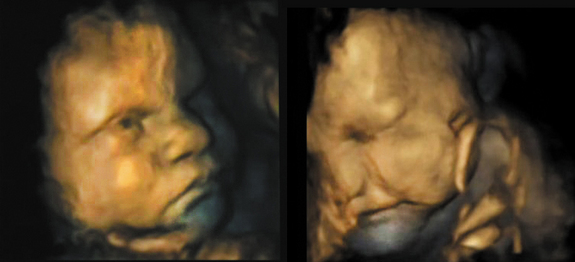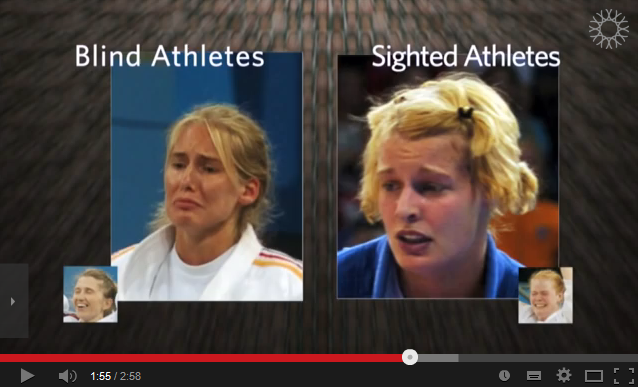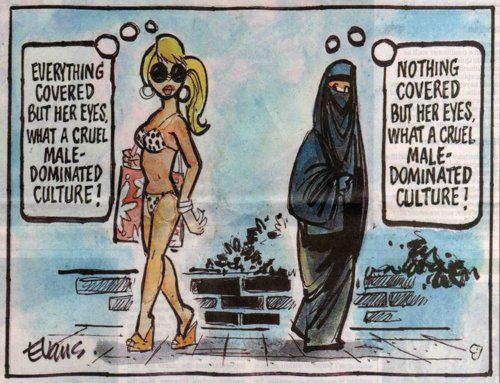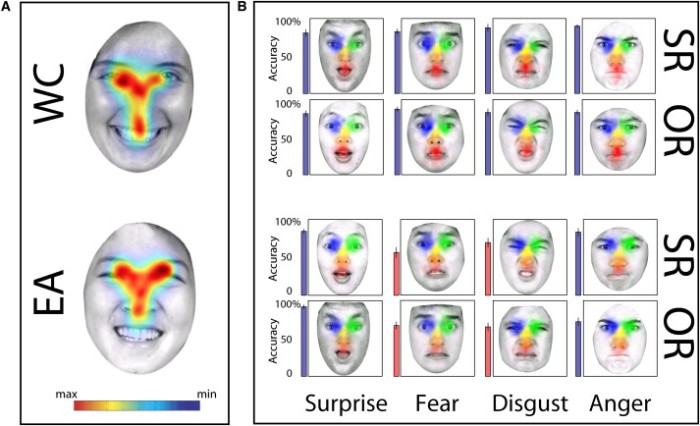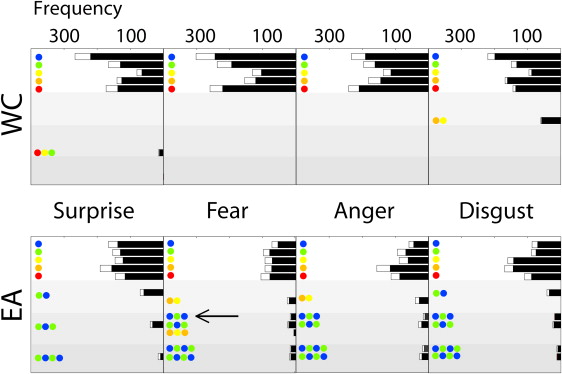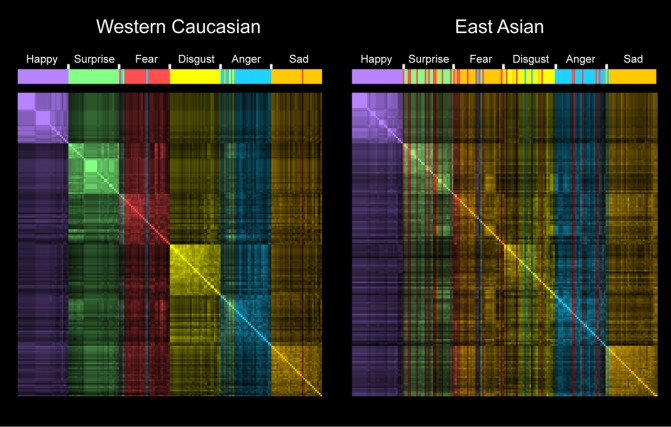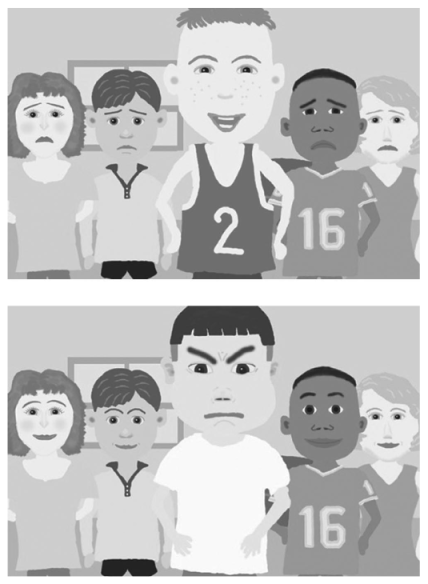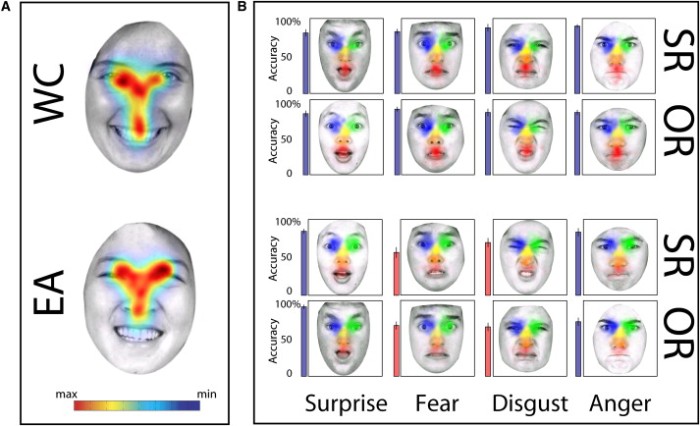Archive for the ‘Culture influences Brain’ Category
Culture Influences Brain / Cultural Differences in Perception
Partly incorporated by the later post Arrow, Circle, Spiral and Cylinder – Different Conceptions of Time and History: Culture influences Brain
.
MIT imaging shows culture influences brain function
Asians and Westeners had to answer questions about absolute quantities (is, is not, how many?) or relative qualities (bigger than, higher than, more red than,…)
It became obvious, that Western people have to spend more energy to render relative judgments (bigger than, lower than, …) than Asians. Vice versa it showed, that Asians needed more energy rendering absolute judgments (is or is not).
~
IMAGE / TREY HEDDEN, MCGOVERN INSTITUTE FOR BRAIN RESEARCH
TechTalk by MIT (Mass. Institute for Technology), volume 52, No. 14 (30.01.2008), J. Gabriell and T. Hedden from the Mc Govern Institute
Download the full pdf here, the article is on page 4 below.
.
.
How Asians and Westerners look at Faces
.
~
(…) Western society is very individualist. Asian societies are much more collectivistic (…) Western approach to facial recognition is piece-by-piece and intimate. The East Asian approach is both more formal and holistic: peripheral information is gathered
(…). We tested some Chinese who had been in Glasgow for three or four years, and you see a clear difference between them and those who just arrived (…). That really demonstrates that it’s not genetic. It’s experience. (…)
Retrieved 14.01.2011 from http://www.wired.com/wiredscience/2008/08/culture-shapes/
.
Read the full research article “Culture Shapes How People See Faces” online here or download as pdf here.
.
Citation: Blais C, Jack RE, Scheepers C, Fiset D, Caldara R (2008) Culture Shapes How We Look at Faces. PLoS ONE 3(8): e3022. doi:10.1371/journal.pone.0003022 Editor: Alex O. Holcombe, University of Sydney, Australia Received June 12, 2008; Accepted July 30, 2008; Published August 20, 2008 Copyright: ß 2008 Blais et al. This is an open-access article distributed under the terms of the Creative Commons Attribution License, which permits unrestricted use, distribution, and reproduction in any medium, provided the original author and source are credited. Funding: This study was supported by The Economic and Social Research Council and Medical Research Council (ESRC) (RES-060-25-0010). REJ was supported by a PhD studentship awarded by ESRC (PTA-031-2006-00192), CB by a PhD studentship provided by the Fonds Que ́cois de Recherche en Nature et Technologies ́be (FQRNT) and DF by a FQRNT post-doctoral fellowship. Competing Interests: The authors have declared that no competing interests exist. * E-mail: r.caldara@psy.gla.ac.uk, retrieved 14.01.2011 from http://www.plosone.org/article/info%3Adoi%2F10.1371%2Fjournal.pone.0003022
.
How Asians and Westerners look at Emotions (Facial Expressions are not universal)
.
Here, we report marked differences between EA (East Asians) and WC (Western Caucasian) observers in the decoding of universal facial expressions. EA observers exhibited a significant deficit in categorizing ‘‘fear’’ and ‘‘disgust’’ compared to WC observers. Also, WC observers distributed their fixations evenly across the face, whereas EA observers systematically biased theirs toward the eye region. A model observer revealed that EA observers sample information that is highly similar between certain expressions (i.e., ‘‘fear’’ and ‘‘surprise’’; ‘‘disgust’’ and ‘‘anger’’). Despite the apparent lack of diagnostic information, EA observers persisted in repetitively sampling the eye regions of ‘‘fear,’’ ‘‘disgust,’’ and ‘‘anger.’’
Download the .pdf here or online here.
Cultural Confusions Show that Facial Expressions Are Not Universal
Cultural Confusions Show that Facial Expressions Are Not Universal – Rachael E. Jack,, Corresponding Author Contact Information, E-mail The Corresponding Author, Caroline Blais, Christoph Scheepers, Philippe G. Schyns, and Roberto Caldara,, Corresponding Author Contact Information, E-mail The Corresponding Author, 1Department of Psychology, University of Glasgow, Glasgow G12 8QB, Scotland, UK, 2Centre for Cognitive Neuroimaging (CCNi), University of Glasgow, Glasgow G12 8QB, Scotland, UK, 3Départment de Psychologie, Université de Montréal, Montreal, PQ H3C 3J7, Canada ,Received 12 May 2009; revised 12 July 2009; accepted 13 July 2009. Published online: August 13, 2009. Available online 13 August 2009.
Current Biology – Volume 19, Issue 18, 29 September 2009, Pages 1543-1548: retrieved 19.02.2011 under http://www.sciencedirect.com/science?_ob=ArticleURL&_udi=B6VRT-4X0FH86-5&_user=10&_coverDate=09%2F29%2F2009&_rdoc=1&_fmt=high&_orig=search&_origin=search&_sort=d&_docanchor=&view=c&_acct=C000050221&_version=1&_urlVersion=0&_userid=10&md5=afe59a73a6b115faacec22215d993939&searchtype=a
.
The Stroop Effect on Morphosyllabic (Asian) and Alphabetical Readers (Western)
Stroop Effect
(1) No interference: Green Red Blue Purple Blue Purple (2) Interference: Blue Purple Red Green Purple Green
In psychology, the Stroop effect is a demonstration of the reaction time of a task. When the name of a color (e.g., “blue,” “green,” or “red”) is printed in a color not denoted by the name (e.g., the word “red” printed in blue ink instead of red ink), naming the color of the word takes longer and is more prone to errors than when the color of the ink matches the name of the color. The effect is named after John Ridley Stroop who first published the effect in English in 1935. The effect had previously been published in Germany in 1929. The original paper has been one of the most cited papers in the history of experimental psychology, leading to more than 700 replications. The effect has been used to create a psychological test (Stroop Test) that is widely used in clinical practice and investigation.
(Wikipedia, retrieved 08.01.2011)
.
.
Stroop Effect on Morphosyllabic and Alphabetical Readers
.
~
Twenty-three Chinese and 24 German undergraduate students were tested in a Stroop paradigm with the following stimuli: color patches, color-neutral words (e.g., friend printed in yellow), incongruently colour-associated words (e.g., blood printed in blue), and incongruently colour words (e.g., yellow printed in blue). Results revealed no differences in German and Chinese students’ response times to colour patches. Chinese participants, however, showed longer colour naming latencies for neutral words as well as for colour words and colour-related words. No differences between German and Chinese participants were found when print colour latencies for neutral words were subtracted from print colour latencies for colour words and colour-related words. This result does not support theories which suggest that for morphosyllabic readers there is a direct route from orthography to the semantics of a word. We rather argue, with reference to dual route models of reading, that access from print to phonology is faster for morphosyllabic than for alphabetic readers, and therefore interference caused by conflicting phonologies of colour name and written word will be stronger in Chinese readers than in German readers.
HENRIK SAALBACH and ELSBETH STERN / Psychonomic Bulletin & Review 2004, 11 (4), 709–715 / Max Planck Institute for Human Development, Berlin, Germany
Download the full pdf here.
See “How Language influences our Thinking” or “Choosing a foreign Name” or search the Category “Language“.
.
Updated 14.01.2011
influences brain function
